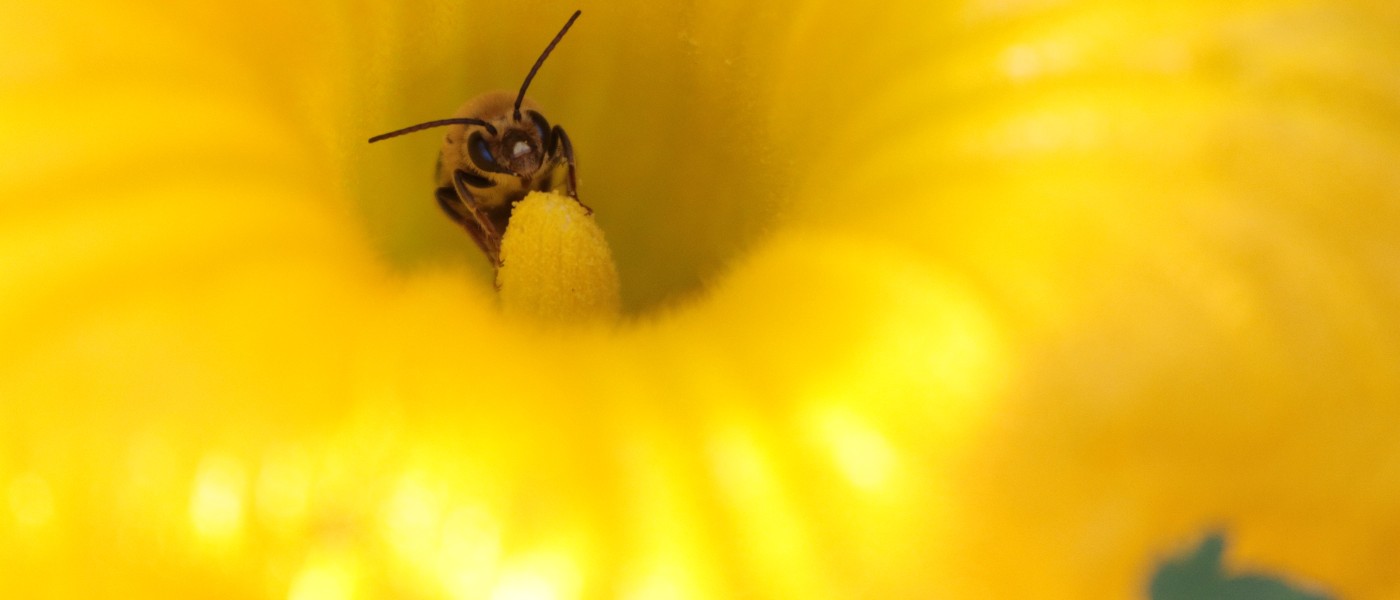About 480 million years ago, during a warm and watery geologic period known as the Ordovician, the first wingless arthropods are believed to have made their way onto land.
Among the earliest terrestrial animals, these creatures’ exoskeletons protected them from the punishing radiation of a land not yet shaded. Land plants, too, were just beginning to emerge.
“Insects have been partnering with plants since their earliest beginnings,” says David Grimaldi, curator of Invertebrate Zoology at the American Museum of Natural History.

By the time the first angiosperms (or flowering plants) evolved around 130 million years ago, insects already ruled the air. Flight allowed them to excel at tracking resources, including from plant to plant.
Pollination—the transfer of pollen from one reproductive organ of a plant to another—was an early feature of this partnership. “I suspect it was a quick courtship” between plants and insect pollinators, says Grimaldi. The earliest angiosperm pollinators included bee-like wasps, tiny moths, and even beetles and thrips.

Grimaldi and colleague Jessica Ware, division chair of Invertebrate Zoology at the AMNH, are part of a team of advisors working with Brooklyn Botanic Garden on this summer’s exhibition, Natural Attractions: A Plant-Pollinator Love Story. Both are curators of the Insectarium at the new Richard Gilder Center for Science, Education, and Innovation, which opened in May 2023.
We spoke with Grimaldi and Ware about the special—if sometimes a little manipulative—relationships that have evolved between plants and insect pollinators, and the threats they face today.
What makes a pollinator?
Nearly 85 percent of the world’s flowering plants rely on animal pollinators to help them produce seeds and fruits. Most of these pollinators are insects, though birds, bats, and even lizards (not to mention people) can be pollinators, too.

Lured into a floral structure while seeking nectar or pollen, insect pollinators—including bees, flies, beetles, wasps, butterflies, and moths—get inadvertently dusted with pollen and spread it around as they move from flower to flower, which results in fertilization.
Bees are especially good at this, “but even cockroaches can be pollinators,” says Ware.
The evolution of specialization
Over millions of years, plants evolved many unique pollinator recruitment strategies, such as vivid colors and shapes that invite certain visitors. “And insects got very good at responding, in an evolutionary sense,” says Ware.
Charles Darwin famously suggested the concept of coevolution after he was sent an orchid from Madagascar with a foot-long nectary. “Good Heavens,” he wrote in a letter, “what insect can suck it[?]” (His prediction—a moth from Madagascar with an extremely long proboscis—later turned out to be correct.)

Some insect pollinators are generalists, able to collect nectar and pollen from many different plant species. Bumble bees (Bombus spp.) and leaf-cutter bees (Megachile spp.) are native generalists that you might see around the Garden. The nonnative European honeybee is another well-known generalist (though they have a tendency to outcompete native bees).
But other plant-pollinator relationships evolved to become much more specialized, with some insects collecting pollen from just one or two types of plants.
It sounds like a risky gamble. But there must be an advantage to being so particular, says Ware. For pollinators, specialization can mean less competition. For plants, it can be more efficient to lure pollinators who are guaranteed to visit other plants of the same species.

Though generalist pollinators are just as important ecologically, specialists can be especially fascinating, says Grimaldi. “Plants actually control the behavior of insects to great advantage.”
Orchids in the genus Dracula, for example, are pollinated by fruit flies attracted by their fungus-like scent. But the orchids aren’t offering nectar or pollen in return—so what is the fly getting out of it?
“It’s getting duped, is what it’s getting,” says Grimaldi.
Insects under pressure
These tight-knit relationships are in peril. If plants and their specialist pollinators don’t emerge at the same time—if the plant blooms a month early, for example— the plant may lose its pollinator, and the pollinator its food source.
“We’ve already started seeing that climate change has led to a time mismatch in some cases,” says Ware. “If that were to continue, whole populations could be lost.”
It’s not just specialist pollinators who are at risk, and the threat is not limited to climate change. Intensive agriculture, habitat loss, pollution, invasive species, and pesticides are all part of the problem. Together, these entwined stressors are driving an alarming collapse in insect populations overall.
According to the 2016 IPBES Global Pollinator Assessment, roughly 40 percent of insect pollinators are threatened with extinction. Research suggests that the world's insect population is declining at a rate of up to two percent each year.
“What we’re doing right now is selecting for a few super-species that can feed on environmental havoc,” says Grimaldi.
The widespread use of pesticides and herbicides is particularly concerning, Grimaldi notes. For the live Insectarium exhibit at AMNH, he recalls, it was difficult to find plants that weren’t treated with insect-killing compounds. “It’s extraordinarily toxic, this stuff.”
In some cases, legislators have begun to take notice: New York State’s recently passed Birds and Bees Protection Act restricts the use of neonicotinoids, systemic insecticides that are banned in the European Union.
“If we continue to see the rates of insect loss that we think we’re seeing, that does not bode well for any organisms on Earth,” says Ware.
What you can do
Individual actions—such as growing chemical-free, pollinator-friendly native plants, avoiding pesticides, turning lights off at night to reduce light pollution, and leaving leaf litter in place as habitat—can be a valuable tool. But one of the most impactful things you can do, Ware and Grimaldi say, is to vote with insects and the planet in mind.
“It’s not just a national issue or an international issue,” says Ware. “It’s an issue for your school board, it’s an issue your mayor should be thinking about. It affects everybody. It’s the fate of all life.”
A version of this article ran in the Spring/Summer 2024 issue of Plants & Gardens, the BBG Members' newsletter.



